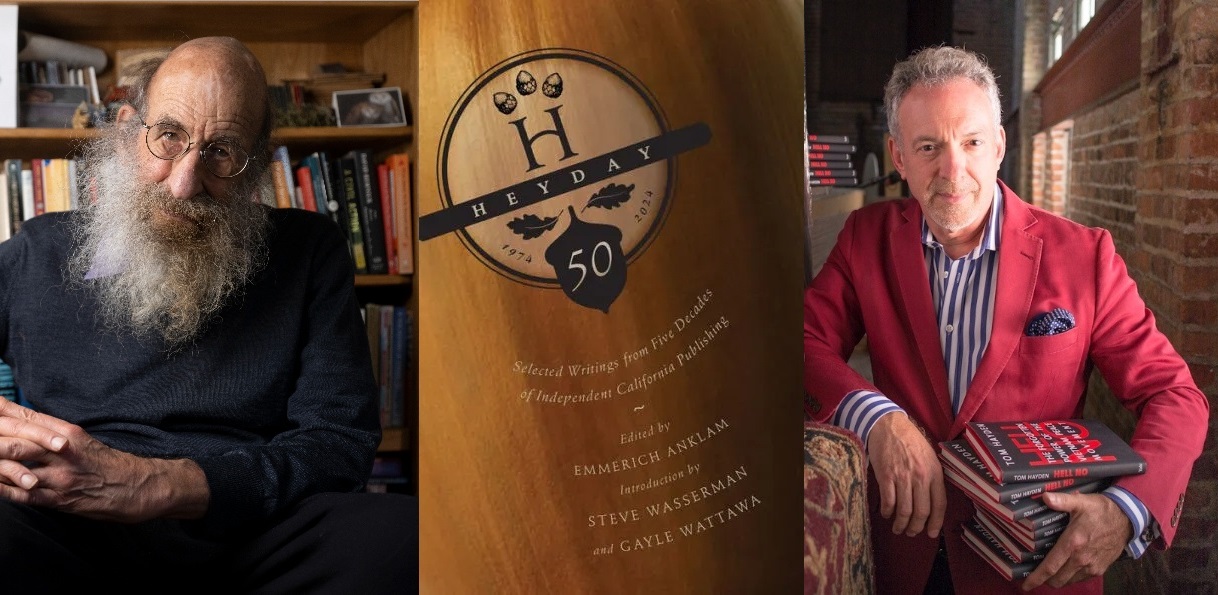When Malcolm Margolin self-published his first book, The East Bay Out: A Personal Guide to the East Bay Regional Parks, in 1974, he had no idea he was launching a future award-winning literary institution. Heyday Books would go on to become an integral part of the firmament of California letters.
Margolin just wanted to get his book into the world; he initially saw the publishing, promoting, and distributing part of the job as unimaginative rote work. “However, I realized that I liked the entire process— from writing and designing, typesetting, distributing and more—and that, for me, publishing was an outgrowth of my writing, one that gave me more control and satisfaction,” Margolin says. “Plus, it was a lot of fun and a lot less isolating.”
Fifty years later, Heyday Books continues to thrive as a fiercely independent nonprofit publisher of titles on California nature, arts and culture, Indigenous perspectives, and social justice. In addition to Margolin’s bestselling second book, 1978’s The Ohlone Way, Heyday has published hundreds of titles, including the immensely popular nature guides of John Muir Laws and the bestselling field atlases of Obi Kaufmann. Now Heyday marks its golden anniversary with the release of Heyday at Fifty (Sept.), an anthology featuring excerpts from Heyday’s deep backlist, with work from luminaries such as Rebecca Solnit, Jane Smiley, and Gary Snyder.
Heyday publisher Steve Wasserman, who took over for Margolin when he retired in 2016, says that Heyday has flourished for five decades by remaining a bespoke publishing house focused on California’s rich history, natural beauty, and place in the collective imagination. “From the beginning, Heyday was built around a big notion of California,” Wasserman says. “Susan Sontag once observed that California was America’s America, a place of relentless invention, a magnet for peoples the world over who sought an escape from history and a new identity in a land of seemingly endless possibility. That destination of desire, of course, came with a cost: the hunting down of its indigenous peoples, the conceit that history’s weight could be ignored, its abundant natural resources plundered. Heyday has done much over the past fifty years to recover that history, to celebrate and nurture the state’s vast natural resources, to explore its people’s relationship to the land, which has given rise to unrivaled prosperity and the stain of persistent inequity.”
Heyday managing editor Emmerich Anklam, who edited Heyday at Fifty, says choosing the excerpts from Heyday’s enormous backlist was daunting. He sought out pieces that were representative of the diverse and excellent work of many of Heyday’s most beloved authors, with a future-oriented lean toward more recent publications. “We wanted the collection to evoke California’s geographic and cultural range, as well as the stylistic range of the authors we’ve published,” he says, “from Greg Sarris in Sonoma County, north to Tony Platt writing about Humboldt, up the mountains to Gary Snyder journaling in the High Sierra, west to Andrew Alden’s and Dorothy Lazard’s Oakland, over to David Mas Masumoto’s Central Valley, south to Susan Straight’s and Gordon Lee Johnson’s Inland Empire, following the highways into Michael Jaime-Becerra’s and Charles Hood’s Los Angeles, and beyond.”
While Heyday is firmly rooted in California, Point Reyes Books co-owner Stephen Sparks says the publisher should not be mistaken for a regional press. “The scope of the press’s inquiry and its progressive political bent ensures that some of the best work being written— and painted, in the case of Obi Kaufmann’s groundbreaking set of books— reaches beyond the confines of the state or even the West, to connect with a wide audience,” he says. A few years ago, Point Reyes Books hosted an appreciation for Margolin. “It was apparent from the number of people in attendance—from Heyday authors to indigenous activists and more—that the press exists not just on paper but in the flesh,” Sparks says. “I don’t know if there’s a better way to sum up Heyday’s impact than that.”
A version of this article appeared in the 04/22/2024 issue of Publishers Weekly under the headline:
